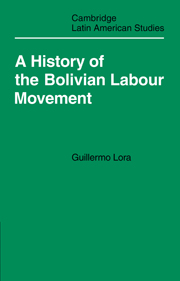Book contents
- Frontmatter
- Contents
- Editor's introduction
- Book 1 Protection versus free trade
- Book 2 Mineowners, artisans and Utopian socialists
- Book 3 Workers and the Liberal Party 1900–20
- Book 4 The nineteen-twenties
- Book 5 From the Chaco defeat to the Catavi massacre 1932–42
- Book 6 The workers become revolutionary
- Book 7 The rise and fall of the Central Obrera Boliviana
- Book 8 The military versus the unions
- Notes
- Editor's suggested reading
- Index
Book 6 - The workers become revolutionary
Published online by Cambridge University Press: 07 September 2010
- Frontmatter
- Contents
- Editor's introduction
- Book 1 Protection versus free trade
- Book 2 Mineowners, artisans and Utopian socialists
- Book 3 Workers and the Liberal Party 1900–20
- Book 4 The nineteen-twenties
- Book 5 From the Chaco defeat to the Catavi massacre 1932–42
- Book 6 The workers become revolutionary
- Book 7 The rise and fall of the Central Obrera Boliviana
- Book 8 The military versus the unions
- Notes
- Editor's suggested reading
- Index
Summary
The Catavi massacre
Conditions in the mines
In order to present objective data on the health and industrial safety conditions which prevailed in the mines at this time, we have selected as an example the Catavi mining company, because it was the largest and best attended. Towards the end of 1948 Dr Guillermo Guerra of the Department of Health and Industrial Safety of the Workers' Insurance and Savings Fund made a study of silicosis and tuberculosis in the Catavi district. Among workers in the interior of the mine he found that the ‘incidence of the disease is very high. 97.84% of the cases had the disease, while only 2.16% were completely free of it’. As an explanatory factor, he mentioned the large numbers of peasants who went to work in the mines. Before moving to the mines the peasant's isolated life, based on small villages with few inhabitants, generally protected him from infection. But this changed with the transition from rural life to large centres and work underground. ‘It is the peasants that must be regarded as the principal factor in the spread of tuberculosis. Over time, as a result of their migrations, and in particular the frequency of migration, they have brought about increasingly higher indices of infection, which are continuing to rise.’
The geological composition of the rocks flanking the principal mineral veins in the Siglo XX mine contains loose silica (Si.O2) in proportions ranging from 23% to 70% and this makes work there extremely dangerous.
- Type
- Chapter
- Information
- A History of the Bolivian Labour Movement 1848–1971 , pp. 214 - 276Publisher: Cambridge University PressPrint publication year: 1977

